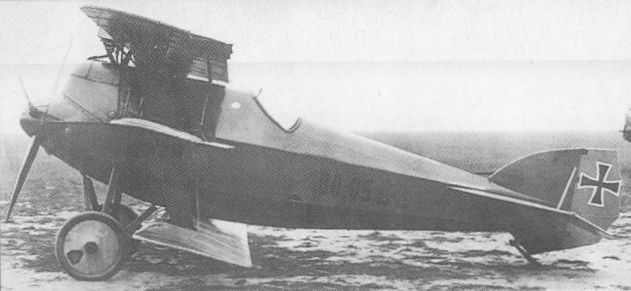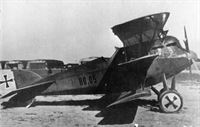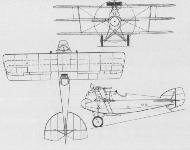
Описание
Страна: Австро-Венгрия
Год: 1917
Fighter
W.Green, G.Swanborough The Complete Book of Fighters
W.K.F. 80.05 Austria-Hungary
The first fighter of original design to be produced by W.K.F. (Wiener Karosserie- und Flugzeugfabrik Dr W v Gutmann), the W.K.F. 80.05 single-bay staggered triplane designed by Ing Alfred Gassner was completed in November 1917. Of wooden construction, it utilised a so-called Fischrumpf, or ‘‘Fish[-shaped] Fuselage”, of hexagonal cross section with plywood skinning, and the wings, which had I-type, aerofoil-section interplane struts, had ailerons on the upper and centre planes only. The W.K.F. 80.05 was powered by a 200 hp Austro-Daimler six-cylinder inline water-cooled engine and provision was made for an armament of twin synchronised Schwarzlose machine guns. Forward view from the cockpit was extremely limited by the very shallow cabane and the radiator bracing, and only limited flight testing of the sole W.K.F. 80.05 prototype was undertaken.
Max speed, 124 mph (200 km/h).
Endurance, 1.5 hrs.
Max range, 155 mis (250 km).
Empty weight, 1,477 lb (670 kg).
Loaded weight, 2,061 lb (935 kg).
Span, 26 ft 2 7/8 in (8,00 m).
Length, 19 ft 9 in (6,02 m).
Height, 9 ft 8 1/8 in (2,95 m).
Wing area, 242.9 sq ft (22,49 m2).
Описание:
- W.Green, G.Swanborough The Complete Book of Fighters
- P.Grosz, G.Haddow, P.Shiemer Austro-Hungarian Army Aircraft of World War One (Flying Machines)
- E.Hauke, W.Schroeder, B.Totschinger Die Flugzeuge der k.u.k. Luftfahrtruppe und Seeflieger 1914-1918
Фотографии
-
W.Green, G.Swanborough - The Complete Book of Fighters
The W.K.F. 80.05 saw only limited testing owing to restricted view from its cockpit.
-
P.Grosz, G.Haddow, P.Shiemer - Austro-Hungarian Army Aircraft of World War One /Flying Machines/
The first version of the WKF 80.05 prototype photographed during flight testing at Aspern in October-November 1917. The tail control surfaces were fabric covered and actuated by control rods within the fuselage.
-
J.Herris - Weird Wings of WWI /Centennial Perspective/ (70)
The WKF 80.05 was a triplane of clean design and excellent workmanship powered by a 200 hp Austro-Daimler engine. The upper two wings had ailerons. The original configuration is shown here. The 80.06 was a biplane derivative of the 80.05 and offered faster speed and climb rate. After the 80.06 crashed during test it was revised, and the 80.06B went into production as the WKF D.I. Almost all prototype triplane fighters powered by inline engines offered better performance as biplanes.
-
J.Herris - Weird Wings of WWI /Centennial Perspective/ (70)
The WKF 80.05 prototype in its original short-wingspan configuration photographed in the WKF factory. The upper ailerons were actuated by a strut connected to the mid-wing ailerons. The high degree of surface polish is clearly in evidence.
-
J.Herris - Weird Wings of WWI /Centennial Perspective/ (70)
The WKF 80.05 was a triplane of clean design and excellent workmanship powered by a 200 hp Austro-Daimler engine. The upper two wings had ailerons. The later configuration of greater span is shown here.
-
P.Grosz, G.Haddow, P.Shiemer - Austro-Hungarian Army Aircraft of World War One /Flying Machines/
The second version of the WKF 80.05 fitted with wings of increased span. To provide the pilot with maximum forward visibility, the radiator has been moved to the wing leading edge.
-
J.Herris - Weird Wings of WWI /Centennial Perspective/ (70)
WKF 80.05 second version showing the open wing struts which replaced the original, single I-strut that had proved structurally deficient in tests performed by Professor Knoller in October 1917.
-
E.Hauke, W.Schroeder, B.Totschinger - Die Flugzeuge der k.u.k. Luftfahrtruppe und Seeflieger 1914-1918
WKF-Dreidecker, Flugzeugnummer 80.05, zweistielig nach Umbau, September 1918, Fliegerversuchskompanie Fischamend
Триплан WKF, номер 80.05, с двойными стойками, после ремонта, сентябрь 1918 г., испытательная рота Фишаменда.











